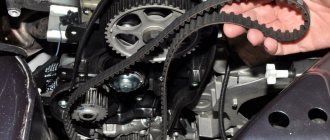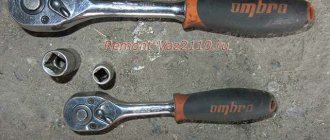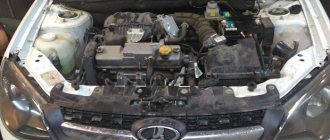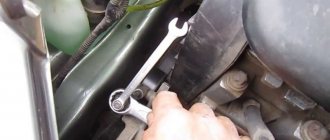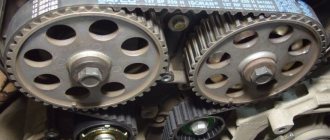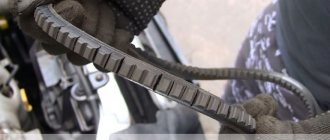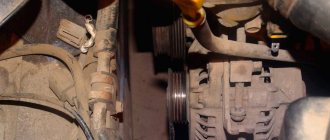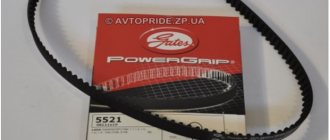The Daewoo Nexia 8-valve is an improved Opel Cadet. The machine is very popular in many regions of the Russian Federation and other CIS countries. In the period from 1996 to 2002, it was equipped with the G15MF power unit. The timing mechanism drive is driven by a timing belt, which requires careful, timely maintenance.
Most owners replace the timing belt on this car by service station specialists, but some of them perform this operation on their own. Nexia, which has 8 valves in the block head, is a reliable machine, unpretentious in maintenance.
Article number and approximate price for the original timing belt for Daewoo Nexia
The Daewoo Nexia uses several engine models. Each engine has its own timing belt. Thus, the 8-valve power plant has a consumable, the article number of which is 96352407. The price for the product ranges from 1,400 to 2,000 rubles.
The Daewoo Nexia with a 16-valve power unit has a timing belt with article number 96814098. The cost of consumables ranges from 2000 to 2700 rubles. General Motors does not produce this belt itself, but purchases it from Goodyear.
Why are timing marks needed?
The timing marks are marks along which the timing belt is adjusted, as well as the drive belt is replaced. This element is quite important because it directly affects the operation of the power unit.
What happens if, when replacing a belt, you set the marks incorrectly or don’t set them at all? In this case, you can knock down the gas distribution mechanism, which will lead to many problems. Namely:
- Since the gas distribution has been disrupted, the injection and release of exhaust gases will be carried out incorrectly. Subsequently, the engine may start to stall, stall, fail to start, or consumption may increase. In turn, this can lead to consequences, such as increased wear, burnout of the valve mechanism and piston group, and others.
- Everyone remembers what happens when the timing belt breaks - valve bending. This happens because the gas distribution process is disrupted and the pistons hit the valves, which are subsequently deformed. The exact same principle works in this case. A broken timing mechanism will cause the piston group to fight against the valves, which will simply deform them.
- Shifting the timing mark when changing a belt or adjusting will result in fuel being injected too early or too late. The consequence of this may be flooding of the spark plugs or suction of exhaust gases into the combustion chamber.
In addition to the induced consequences, others may also arise, which can also lead to increased wear and tear of power unit parts or other problems.
Article number and cost of analogues of the original timing belt Daewoo Nexia
Since the original timing belt has a high cost, car owners resort to purchasing products from third-party manufacturers. The best brands of consumables are presented in the tables below.
Table - Good analogues of the Daewoo Nexia timing belt with an eight-valve engine
| Manufacturer | vendor code | Approximate cost, ruble |
| Polcar | BS1987949082 | 360-440 |
| Tashido | EK3103TD | 200-250 |
| Dongil | 111RS17 | 420-500 |
| Bosch | 1987949194 | 380-450 |
| A.E. | TB336 | 400-460 |
Table - Recommended analogues for the Daewoo Nexia branded timing belt with a sixteen-valve power plant
| Manufacturer | Catalog number | Approximate cost, ruble |
| Continental | CT887 | 300-390 |
| Onnuri | 96183352 | 370-420 |
| Bosch | 1987949403 | 560-730 |
| Gates | 5419XS | 630-890 |
| Goodyear | G1203H | 320-370 |
The timing drive system contains elements that have a service life comparable to the service life of the belt. When it needs replacement, other worn-out parts should also be replaced. For these purposes, it is recommended to purchase a ready-made set of spare parts. The best timing drive maintenance kits are presented in the table below.
Table - Recommended kits for replacing the Daewoo Nexia timing belt
| Manufacturer | Catalog number | Approximate cost, ruble |
| Gates | KP15310XS | 2600-3500 |
| Contitech | CT874WP2 | 3000-3700 |
| Metelli | 3004421 | 2900-3800 |
| SKF | VKMC05121 | 3200-4500 |
| INA | 530000430 | 3100-4200 |
About the engine
Initially, the car was equipped with a G15MF engine running on gasoline. The power system is distributed fuel injection. The engine displacement is 1500 cm3, the camshaft is located in the cylinder head, ensuring operation of 8 valves of the gas distribution mechanism. The timing mechanism is driven by a toothed belt. The engine is capable of developing a power of 75 horses. The disadvantages include poor performance of the distributor in the ignition system.
Later it was replaced by the modification A15SMS, which, with the same displacement, already develops 80 horsepower. The power system has a distributed multipoint injection; the unreliable ignition distributor is no longer used. There are 8 valves installed in the head, the camshaft is driven by a toothed belt. This type of drive requires careful maintenance and care. Experts recommend checking the condition of the timing drive mechanism parts during each regular maintenance.
Are the valves bending?
This problem worries all owners of cars whose timing mechanism is driven by a toothed belt. Its failure can lead to significant damage to engine parts, which will require significant financial costs. Designers are trying to find ways to solve this problem. Most often, engines with four valves per cylinder are susceptible to this problem. For engines G15MF, A15MS, there is no danger of bending valves, damage to pistons or connecting rods.
Read also: Turbine from Kamaz to VAZ
Required tools and materials for DIY replacement
Before you begin replacing the timing belt, it is recommended to check the availability of the tools that are presented in the table below.
Table - Tools and materials required to replace the timing belt
| Name | Note |
| Jack | To lift the car |
| Jack | For hanging the engine |
| Screwdriver | With flat and cross blade |
| Socket wrench | “at 10”, “at 12”, “at 13”, “at 14”, “at 17” |
| open-end wrench | Set |
| Socket wrench | “at 10”, “at 12”, “at 13”, “at 14”, “at 17” |
| Head | Kit |
| Kardanchik | To access some fasteners |
| Vorotok | With ratchet and extension |
| Torque wrench | To control the tightening torque of threaded connections |
| Special tools | Key “41” for unscrewing the pump. You can make it yourself from available materials. |
| Retainer | Pulley holder |
| Pliers | Several types |
| Hexagon | "at 8" |
| Wire brush, rags and carburetor cleaner | For cleaning work surfaces |
| Penetrating lubricant | For example, WD-40 |
Replacing the timing belt on a sixteen-valve Daewoo Nexia
Instructions for replacing the belt on a 16-valve engine are presented below.
- Remove the coolant reservoir.
- Remove the air duct.
- Remove the air supply hose.
- remove the air filter.
- Remove the pipe.
- Loosen the power steering pulley bolts.
- Loosen the generator bolts and then move it.
- Jack up the car and remove the wheel.
- Remove the protective cover.
- Unscrew the screws of the timing drive protective cover.
- Remove the casing.
- Jack up the engine.
- Unscrew the engine mount.
- Unscrew the crankshaft. It is recommended to use an impact wrench and a pulley clamp. If they are absent, you can brake the car and unscrew the mount using the lever.
- Check the labels.
- Unscrew the power steering pump.
- Pull out the belt.
- Install a new belt, checking the timing marks, turning the crankshaft 2 turns.
That's all.
Let's get started
We remove the air intake pipes, the air filter housing and everything connected to them. This is the picture we get.
Unscrew the bolts securing the protective timing cover and remove it. We also loosen the bolts securing the power steering pulley. So that he doesn’t swear later trying to stop him.
Loosen the generator mounting bolt, move it towards the engine and remove the generator belt.
Remove the right wheel and the plastic mudguard from below. Drain the antifreeze.
Now we see the crankshaft pulley.
Use the crankshaft bolt to rotate the entire gas distribution mechanism until the mark on the camshaft pulley and the housing coincide.
Remove the power steering pulley. The photo has already been taken. But the crankshaft mark is visible and it coincides with the pointer. Unscrew the two hydraulic booster mounting bolts. Do not drain the power steering fluid!
We remove the crankshaft pulley and see that the marks on it match. Unscrew the crankshaft bolt with the help of a partner. We engage fifth gear, press the brake and unscrew it with a slight movement of the hand.
Unscrew the bolts of the lower protective cover and remove it.
Loosen the three pump mounting bolts; they are hexagonal. They are not visible in this photo; after removing the protective casing, I will mark them. Using a special wrench, turn the pump until the timing belt loosens and remove it. Remove the camshaft pulley. The bolts for fastening the protective casing were hidden under it. And two more below. We unscrew them.
We move the casing and see just three bolts securing the pump.
And on top is the hero of the occasion, the thermostat in its own housing. We remove it and change it.
We remove the water pump and lubricate its gasket with a thin layer of sealant to prevent it from leaking later. There is no point in changing it, it is still new.
Thermostat, special key and water pump.
We put the water pump in place. There is a tension indicator on the tension roller; after tensioning the belt, the arrow should be opposite the groove.
We put the protective cover in place, screw it and the tension roller. We install the camshaft pulley and align the marks, if they do not match, we also check the crankshaft marks. Then we install a new timing belt so that the descending branch of the belt is tensioned. The principle is this: first we put it on the crankshaft, pump and tension roller. Then we turn the camshaft pulley a few degrees clockwise, put a belt on it and return it back. It turns out that the right branch of the belt is tense, and the left is free. We must place the belt in the direction of rotation , there is a special mark on it for this, unfortunately we didn’t take a photo here, but you can see it in the article about Logan.
Read also: How to register pressure sensors in Mercedes tires
Using a special wrench, turn the pump until the arrow on the tension roller is against the groove and tighten it.
We check all the marks again. If everything is normal, install the lower casing and crankshaft pulley, tighten it in the same way as you unscrewed it. We turn the crankshaft twice and check the marks.
We screw back everything that was unscrewed and put everything that was removed in the reverse order of removal. Tension the generator belt. Fill with antifreeze. We start the car and accept congratulations from family and friends.
Overall the car is quite good. The front suspension couldn't be simpler, two silent blocks and a ball, which is very difficult to kill. Engines last 300,000 without problems. He does not have a high appetite. The only thing is that there are several congenital electrical defects, and the body rots if not treated. But otherwise, for the money it’s worth, it’s a perfectly acceptable option. These were discussions on a free topic.
